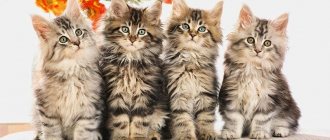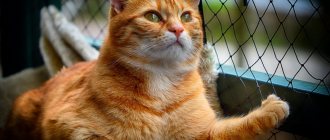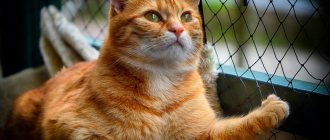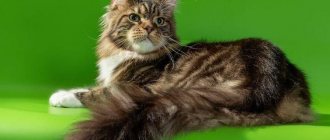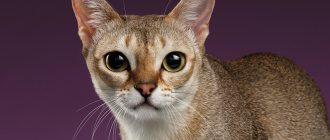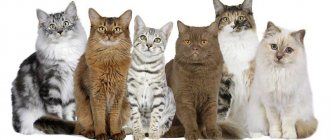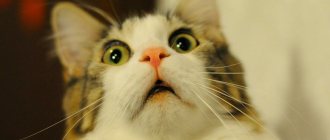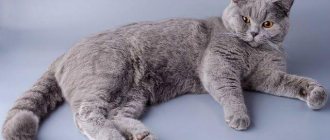Cats have long taken their rightful place on the list of the most popular pets. But many people are not ready to put up with heavy shedding and it is because of this that they deny themselves the pleasure of having a purring pet. Especially for them, breeders have developed several breed varieties, whose fluff does not settle in clumps on clothes and furniture.
Let's figure out which cat breeds don't shed and what to do to prevent them from smelling.
Features of non-shedding breeds
The shedding process is considered a physiological norm for most breeds of domestic cats. Therefore, they all lose their fur to one degree or another. Of course, those with short fur coats shed less fluff than their shaggy counterparts with a voluminous undercoat.
All low-shedding breeds have a number of features:
- absence of down or guard hair;
- presence of coarse or curly hair.
Thanks to this, such cats hardly shed, and are also less likely to cause allergies.
Siamese
This breed is quite fluffy. However, they shed much less than other pets. Siamese cats have thin and short hair that falls out relatively rarely. You can further reduce shedding by brushing your Siamese weekly with a fine-tooth comb.
List of breeds that do not shed or smell
Experts work tirelessly to develop varieties that do not smell and hardly shed hair. And they have already managed to achieve certain results.
The list of existing cat breeds that do not shed or smell under certain conditions includes:
- naked cats;
- rexes;
- Siamese-Oriental group;
- Russian blue;
- Nibelung;
- Bengal.
Hairless cats
These are partially or completely hairless cats with thick, hot skin. This category includes:
- all types of sphinxes (Canadian, St. Petersburg and Don);
- selective breeds obtained with the participation of hairless cats (Ukrainian Levkoy, Dwelf, Elf and Bambino).
Canadian Sphynx
Peterbald cat
Don Sphinx
All sphinxes are conventionally divided into subgroups:
- Naked. Such cats are born without topcoat hair and without undercoat. They often do not have eyebrows or mustaches.
- Flock and velor. These Sphynx cats have a light undercoat. In some of them, fluff grows all over the body, in others - only on the muzzle and certain parts of the body.
Although hairless cats have virtually no hair, they require careful grooming. They secrete a specific secretion that accumulates on the skin and begins to smell unpleasant. In addition, sphinxes can leave greasy stains on upholstered furniture. Therefore, it is recommended that hairless cats be wiped daily with wet wipes and bathed frequently.
Sphynxes also need a special diet, any deviation from which causes them to sweat profusely. As a result, acne appears on their skin.
Rex
This group of cats, which do not shed or smell, includes breeds with short, wavy fur and no undercoat. Rex species include:
- Devon Rex with hypoallergenic, virtually odorless coat. He does not shed at all, but due to skin secretions, his fur quickly becomes greasy and requires frequent washing.
- Cornish Rex with a sparse undercoat that looks like fluff. Due to its elongated muzzle and large eyes, it is often compared to an alien.
- Selkirks, Laperms, German and Ural rexes with a curly coat reminiscent of sheep's fleece. Representatives of these breeds can have both short and long hair.
Devon Rex
Cornish Rex
Selkirk Rex
Laperm
Ural Rex
All these cats, when properly cared for, have virtually no odor, are not prone to heavy shedding and do not need to be combed. Unlike sphinxes, rexes are not afraid of cold weather and do not require complex care.
True, with an unbalanced diet, dark spots appear on their back and sides. Therefore, owners will have to carefully monitor the diet of curly-haired cats.
Siamese-oriental group
It unites cat breeds whose ancestors lived in countries with warm climates and did not have the need to shed their fur coats.
The Siamese-oriental group includes:
- Siamese;
- Abyssinians;
- orientals;
- Thais;
- Burmese;
- Balinese;
- skif-tay-dons;
- Mekong Bobtails.
Siamese cat
Abyssinian cat
Oriental cat
Thai cat
Burmese cat
Balinese cat
Skif-tay-don
Mekong Bobtail
All of them have short, shiny hair that lies close to the body and does not require special care. Their guard hair changes almost imperceptibly, and to maintain a neat appearance it is recommended to iron them daily with wet hands.
Important! Cats of the Siamese-Oriental group practically do not shed and do not smell. If oriental pets have severe awning, they must be shown to a veterinarian. Excessive shedding, which is unusual for them, can be caused by stress, hormonal imbalances and serious diseases.
Russian blue
Despite the fact that this cat practically does not shed and does not smell, it has both a luxurious coat and a thick undercoat. The hair of the Russian Blue has a unique structure that does not allow it to break. Due to this, the cat changes its coat throughout the year, but at the same time sheds unnoticed by its owners.
On a note. Russian Blue does not require special care. Her lightly shedding hair is not recommended to be combed out frequently and washed using aggressive products.
Nibelung
This non-shedding cat is very similar to the Russian Blue. But, unlike the latter, the Nibelung has a semi-long coat. The unusual fur of a cat of this breed is characterized by reduced fragility, due to which it practically does not shed.
Bengal
This hybrid of a wild and domestic cat is almost non-shedding and odorless. The main feature of the Bengal is that at the age of a week it begins to phasing. During this natural process, the cat's coat becomes shorter than the undercoat, and the bright spotted coloring becomes covered with a dark veil.
At the age of 4-9 months, the Bengal's fur falls out completely, and the hair becomes smooth and shiny. Subsequently, the undercoat of a hybrid cat does not grow, which means it never sheds again.
Cornish Rex
The Cornish Rex breed is often called alien cats due to their unusual appearance. The structure of the fur coat of these short-haired pets resembles astrakhan fur, since waves of different depths and widths are dispersed throughout the woolen blanket. Their large mysterious eyes and huge ears also attract special attention.
The color palette of the breed includes many colors and their combinations, asymmetrical patterns and white spots against the background of the main color.
This is interesting: Fir Oil Medicinal Properties and Applications
The character of Cornish Rex creatures has a lot of positive aspects:
- friendliness and affection for the owner;
- sociability and high activity;
- perfect memory and desire to help the owner in daily affairs.
Due to their high mobility, these creatures have a gigantic appetite, destroying huge amounts of food. In view of this feature, it is necessary to monitor the diet of such a cat, otherwise it will gain excess weight.
Cornish Rexes are a very healthy cat variety. With sufficient care and constant activity, these animals can live up to 20 years or longer. From 16 weeks of age, kittens must be taught to bathe, since the amount of hair is not enough to absorb sebaceous secretions, which can lead to the development of skin diseases.
Pros and cons of non-shedding cats
A cat that doesn't shed has its advantages and disadvantages:
| pros | Minuses |
| No loose hair on carpets and furniture | Difficulty in skin care (hairless breeds) |
| Hypoallergenic | Special dietary requirements (for Sphynxes) |
| No need for frequent brushing |
The list of cats that don't shed or smell when properly cared for includes many dissimilar breeds. Therefore, it will certainly be useful not only for allergy sufferers, but also for those who dream of a four-legged pet, but are not ready to put up with balls of cat hair and the need to frequently clean.
Oriental Shorthair
Oriental Shorthairs are related to Siamese cats, so they also shed little. Their coat is short and smooth, and does not require special care. But these fluffies want and demand a lot of attention from their owners!
According to your lifestyle
The situation in the house and the owner’s life principles are an important aspect when choosing a cat breed. Not all breeds will be comfortable in every family.
For busy people
If the owner is rarely at home, he needs a cat that does not require a lot of communication and care. Such a pet must have a self-sufficient character.
Check out the following cat breeds if you consider yourself a workaholic:
Woman looking out the window
Scottish cat
They do not require unnecessary attention. Such cats will happily greet their owner from work, but will not bother him if he is not in the mood. These pets do not require complex care and will always find something to do on their own.
For children
If a child asks to buy a kitten, choose from good breeds of cats. The pet must be patient so as not to get angry from pranks. Breeds that will enjoy children's play:
Good disposition and doggy character
Devoted entertainer
Obedient purring beauty
Turkish van
Suitable for a child if he becomes his owner. For children, you should not choose wayward cats and pets who prefer a quiet holiday. Incompatibility of interests leads to cat and child trauma.
For single people
People living alone often lack communication. Such a person should choose a cat with an affectionate character. Devoted cats will happily brighten up the evenings with their purring:
Curious and funny talker
Japanese Bobtail
Loyal purring friend These cat breeds become attached to people and love attention. Such cats will create comfort in your home and will bring you extremely positive emotions.
For a private home
A person living in his own home needs a hunter cat. The pet must be able to exterminate rodents and walk in the yard on its own. If your home needs a rat catcher, take a look at the following breeds:
Turkish van
Pied Piper from the Eastern Continent Natural rat catchers will always stand guard over their master's house. To catch rats, it is better to choose a cat rather than a cat: they show the best hunting qualities.
For a family that already has pets
One pet in the house is never enough - there is enough love for everyone! To ensure smooth communication between your old and new pet, choose from friendly cat breeds:
Lapermas
Another breed with a deceptive appearance. They look very fluffy and have wavy, thick fur. However, they are hypoallergenic and low shedding. But for people who are very busy and cannot devote enough attention and time to their pets, these cats are not suitable. After all, they are very affectionate and love communication.
Siberian
Siberian cats have long and thick hair. Therefore, it gives the misleading impression that these fluffies shed a lot. However, due to the increased activity of the sebaceous glands on the skin, their hair falls out much less frequently than other breeds. By the way, Siberian cats belong to the hypoallergenic group. Therefore, they can be safely adopted by those who usually sneeze, cry and itch when being around felines.
Veterinary question
If it is not clear why the cat sheds a lot, the fur falls out in clumps, or bald patches appear, then its health and immunity need protection.
Wool is actively involved in the body's defense processes, so make every effort to restore your pet's immune balance. A veterinarian and a blood test for hormones will help with this.
Two groups of diseases can be considered, which are diagnosed by the volume and quality of baldness. These are parasitic diseases and endocrine pathologies.
Parasites can be easily detected by scratching and brittle hair on the neck, behind the ears, at the base of the tail and on the tummy. Endocrine disorders are usually expressed by symmetrical baldness (there is no hair at all on rounded bald patches).
Sometimes the cause of the loss of the spine and down is a recent illness. If little time has passed since the cure, then excessive shedding in the coming season is considered a physiological norm.
We put these three reasons on a par because there are many interrelations between them. Allergies often manifest themselves under stress, and poor nutrition can provoke allergic reactions at any time of the year.
First of all, switch your cat to a balanced diet for sensitive and allergy-prone pets.
Find out what the cat's metabolism is lacking, eliminate stress and check whether preventive measures have been taken for a long time.
If your purr constantly sheds, but no diseases are found in him, then you need to consult with a specialist on what to do and how to properly care for his coat in order to keep it healthy and beautiful.
The result of any of your efforts and treatment can be assessed in the coming season. When the cat begins to shed regularly only in spring and autumn, we can assume that you have found the ideal balance between nutrition, care and breed characteristics of your pet.
Tonkinese
These cats come from Canada and are the result of crossing Burmese and Siamese four-legged cats. They are very affectionate, playful, highly intelligent and easy to train. But they rarely shed, so there won’t be any special problems with daily care.
Turkish Angora
This is one of the most ancient and beautiful cat breeds. Most of these noble beauties are white, but there are also pets with “gray” hair. They don't shed much, which is great! After all, there is nothing more tedious than endlessly collecting white wool from everything around - from clothes to furniture. These cats have a very interesting and active temperament and enjoy playing and having fun with their owners.

